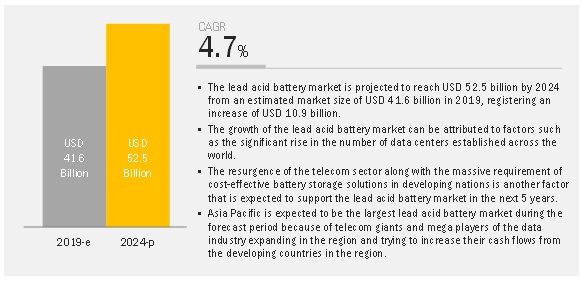Global Lead Acid Battery Market Overview:
According to the new market research report, the global lead acid battery market is projected to reach USD 52.5 billion by 2024 from an estimated USD 41.6 billion in 2019, at a CAGR of 4.7% during the forecast period. This growth can be attributed to factors such as the need to integrate renewable energy to the main grid, and the booming data industry promising the installation of several data centers across the globe, which expects the utilization of lead acid batteries for backup power supply.
A lead acid battery is an energy storage device that is used extensively in automotive, energy storage, and telecommunication industries and for several other purposes in various sectors, such as utilities, marine, manufacturing, and chemical & pharmaceutical industries.
Download PDF Brochure @ https://www.marketsandmarkets.com/pdfdownloadNew.asp?id=161171997
The VRLA segment is expected to be the largest lead acid battery market, by construction method, during the forecast period
The Valve Regulated Lead Acid (VRLA) segment is expected to be the largest market during the forecast period. The VRLA batteries comprise absorbent glass mat (AGM) and gel cells. These are new technology-driven construction methods, including the presence of adsorbent glass material and silica gel, respectively. These methods ensure the longevity of the batteries and require less maintenance compared to regular lead acid batteries. In the times to come, these batteries are likely to be preferred over conventional flooded lead acid batteries due to their various advantages.

The advanced lead acid battery is expected to be the fastest-growing segment of the lead acid battery market, by technology, during the forecast period
The advanced lead acid battery has carbon coatings on the anode plate, which eliminates the requirement of cleaning the lead sulfate deposition on the electroplate. At the same time, the life of the anode electrode is enhanced, eventually increasing the overall life of the battery set. It provides benefits like rapid charging on regenerative breaking. This is a significant advantage of advanced lead acid batteries, as this task is difficult to achieve with regular lead acid batteries. Although comparatively heavier and larger than lithium-ion, these batteries are cost-effective, efficiently operating at low and subfreezing temperatures, and does not require active cooling.
Ask Sample Pages of the Report @ https://www.marketsandmarkets.com/requestsampleNew.asp?id=161171997
Asia Pacific to account for the largest share of the global lead acid battery market
In this report, the lead acid battery market has been analyzed with respect to five regions, namely, North America, South America, Europe, Asia Pacific, and the Middle East & Africa. The Asia Pacific region is estimated to dominate the global lead acid battery market in 2019, owing to the requirement of cost-effective energy solutions. The presence of a large automotive and manufacturing base in the region is expected to be the key driver for market growth. Increasing energy consumption in the area due to rapid industrialization and urbanization is expected to propel the growth of the market over the forecast period.
The report includes the profiles of some of the top players in the lead acid battery market to enable an in-depth understanding of the competitive landscape. Some of the key players are EnerSys (US), Exide Industries (India), GS Yuasa (China), Clarios (US), Panasonic (Japan), Chaowei Power (China), Narada Power (China), HBL Power Systems (India), Crown Battery (US), NorthStar (Sweden), Hitachi Chemical (Japan), Exide Technologies (US), Teledyne Technologies (US), East Penn (US), Hankook AltasBX (Korea), HOPPECKE (Germany), C&D Technologies (US), Rolls Battery (Canada), Camel Power (Malaysia), Amara Raja Power System (India), XUPAI Battery (China), Okaya Power (India), Leoch International Technology (Hong Kong), Harbin Coslight Power (China), and First National Battery (South Africa). The leading players are adopting various strategies to increase their share in the lead acid battery market.


